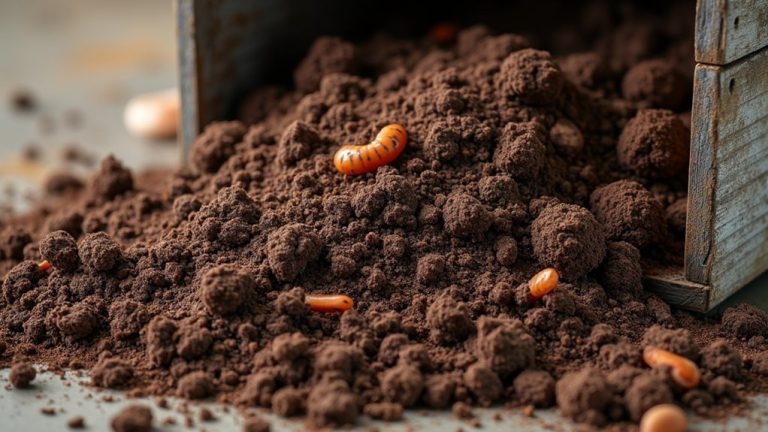Jump Start Spring With a Cold Frame Garden
Wanna jump-start your spring garden? A cold frame garden is the way to go! It’s like having your own mini greenhouse where you can plant leafy greens and radishes much earlier. You’ll love how it keeps your plants cozy, even when the weather’s being moody.
Don’t worry about being fancy—just use some old windows and make a little box that’s taller in the back for sun. Keep an eye on the temperature, water wisely, and your plants will thank you with epic harvests. Curious about the perfect veggies to grow or how to maintain your cold frame? Keep on exploring!
TLDR
- A cold frame extends the growing season, allowing for early spring planting of cold-hardy crops like leafy greens and radishes.
- Construct your cold frame using recycled materials, ensuring proper ventilation and optimal sun exposure for healthy plant growth.
- Monitor temperatures and maintain a range of 70-75°F, using insulation at night to protect plants from cold.
- Regular maintenance, such as checking soil moisture and clearing debris, ensures thriving plants and greater yields.
- Enjoy quicker harvests and diverse options by planting a variety of vegetables suited for cold frame gardening.
Cold Frame Basics

Cold frames are a gardener’s best friend when it comes to extending the growing season. These nifty little structures let you grow cold-hardy crops like leafy greens and radishes earlier in the spring.
To guarantee a clean and enjoyable gardening experience, consider adding simple solutions for dogs around your cold frame, especially if you have pets that enjoy the outdoors.
Temperature Management Techniques
Managing temperature inside your cold frame is crucial for healthy plant growth. To promote strong root systems and overall plant health, consider incorporating regular aeration techniques to improve soil structure.
You’ll want to monitor the air temperature with a thermometer, aiming for 70-75°F during the day for warm-season crops.
On sunny days, prop open the lid for ventilation to prevent overheating. Don’t forget to insulate with agricultural cloth at night to keep your seedlings cozy.
Ideal Vegetables for Cold Frames

When you’re planning what to grow in your cold frame, think about leafy greens like lettuce and kale, which love cooler temperatures—it’s like a spa day for them!
Both of these greens are hardy and can thrive in low temperatures, making them perfect for your cold frame. You can also get creative with root veggies like radishes and baby beets, and trust me, there’s nothing more satisfying than pulling out a fresh radish just a few weeks after planting.
For even more options, consider adding the best winter vegetables to your garden for a diverse harvest.
Leafy Greens Selection
A cold frame is the perfect environment for growing a variety of leafy greens that thrive in cooler temperatures. Imagine biting into crisp leaf lettuce, tender kale, or zesty arugula, all ready for your plate!
Plant these cool-season greens in early spring for quick harvests. Just remember, regular thinning not only keeps them healthy but also gives you tasty snacks—yum!
Root Vegetable Options
Growing leafy greens is just the beginning of what a cold frame can offer. As a vegetable gardener, you’ll love how radishes thrive, maturing in just three weeks!
Try baby beets, Japanese turnips, and carrots for early harvests, too. Don’t forget scallions—they’re easy to grow and perfect for your cold frames.
With the right care, your spring garden will be thriving!
Watering and Maintenance Tips
Proper watering and maintenance are essential for a thriving cold frame garden. Always check soil moisture at about ¼ inch deep before watering—remember, it’s better to wait than to drown your young greens!
Incorporating coffee grounds can enhance soil health, providing essential nutrients and improving moisture retention.
Keep an eye out for pesky pests and wipe down cold frame tops for better light. After harvesting, clear the debris and enrich your soil with compost.
Building Your Cold Frame

Building your cold frame is a fun and rewarding project, so grab some wood and get ready to channel your inner DIY guru!
You’ll want to think about materials—old windows are perfect for that transparent covering, and they add a bit of character, too.
Plus, when you design it with the back a bit taller than the front, you’ll be giving your plants the best sunbathing spot possible—who wouldn’t want that?
Materials for Construction
When constructing your cold frame, the choice of materials plays an essential role in its effectiveness and longevity.
You can use recycled materials like old windows or wood to create a charming, eco-friendly design. For clear covers, opt for glass or polycarbonate, and don’t forget about insulation!
Proper ventilation, like hinged lids, keeps your cold frame cozy without turning it into a sauna.
Design and Dimensions
Designing your cold frame with the right dimensions is crucial for maximizing its effectiveness. For ideal sunlight exposure, aim for about 4 feet wide by 8 feet long and a back height of 3 to 6 inches.
Use sturdy materials like 2×3 lumber and guarantee proper drainage with a slight slope. Don’t forget hinged lids for easy ventilation—your plants will thank you!
Benefits of Cold Frames
Cold frames offer gardeners a unique opportunity to extend their growing season and protect delicate plants from unpredictable weather.
They create cozy microclimates, keeping temperatures 10-15°F warmer, perfect for growing leafy greens and other crops.
Plus, they’re easy on your wallet, using recycled materials! Just remember, regular maintenance is key for happy plants and bountiful harvests.
Isn’t that awesome?
Overall
So, there you have it! Cold frames are like magical little greenhouses that can get your garden going before spring truly kicks in. You’ll be growing delicious veggies faster than you can say “fresh salad!” Just remember to keep an eye on the temp and water your plants, and soon you’ll be harvesting those tasty treats.
Trust me, there’s nothing quite like munching on veggies you’ve grown yourself. So, grab some materials, and let’s get gardening! 🌱







